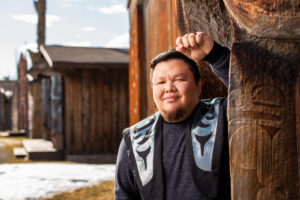
People & Culture
Power in our knowledge
How Hetxw’ms Gyetxw (Brett D. Huson) weaves together Gitxsan ways of knowing into his series of children’s books
- 2678 words
- 11 minutes
This article is over 5 years old and may contain outdated information.
People & Culture

Acadia today is both a place and a people. While the term is often used to refer to a vast swath of the Maritimes, including New Brunswick and parts of Nova Scotia, it can also refer to the Acadian people, who are spread out around the world and are “right fiers” (“very proud”) of their East Coast heritage. If all you know about l’Acadie is lobsters, fiddleheads and Evangeline, here are five facts to help you “fêter” the Acadian national holiday, celebrated each year in Canada on August 15.
Throughout the early 1700s, Acadians were caught between the warring French and British armies. Though they had lived on British-controlled lands in Nova Scotia since 1713, Britain feared that the Acadians would side with the French in any future military conflicts. In 1755, with new tensions mounting, French-speaking Catholics were forced to renounce their religion and swear allegiance to Britain. Those who did not were stripped of their lands and holdings and separated from their families in what became known as “Le grand dérangement” or Great Deportation.
Acadian deportees were shipped as far away as the Falkland Islands and France; some found their way to Louisiana, attracted by the strong French presence there. While many eventually returned to the Maritimes after 1764, Cajun culture is still strong in Louisiana (“Cajun” comes from an English mispronunciation of the French word “Acadien”).
Legend has it that when Italian explorer Giovanni Verrazano landed somewhere between modern-day New York and Nova Scotia in 1524, he called the territory “Arcadia,” after the province in Greece. Apparently the northeast coast of North America was so beautiful that it reminded Verrazano of the Greek toponym describing a state of pastoral idyll.
However, another theory suggests that Acadia comes from the Mi’kmaq term “cadie,” loosely translated as “place of abundance.” The term is found in other place names in the region too, including Tracadie, N.B., and Shubenacadie, N.S.
J’ai endé up ici. Worrie pas ta brain. Nous sommes right fier.
Chiac is a dialect that is spoken throughout the region. It’s French-based but often borrows words from English, even going so far as to conjugate English verbs. The dialect also incorporates old French words that have fallen out of Québécois French usage.
Country singer and New Brunswick native Amélie Hall even wrote a song in Chiac called “Worrie pas ta brain,” a popular saying which essentially boils down to “Even if you feel your day’s not going well, it’s okay, we keep moving on.”
When you think of poutine, you may think of an after-hours greasy-spoon joint beckoning hoards of less-than-sober Montrealers with a savoury pile of fries, squeaky cheese curds and gravy. But go to Moncton and ask for poutine and you’ll be thrown for a loop if you’re unfamiliar with the local cuisine.
La poutine râpée, or poutine acadienne, looks like an oversized and boiled perogy. Its outer layer blend of mashed potatoes and grated raw potatoes envelops a pork meatball interior. The doughy blob is then boiled until cooked through and can be served with anything from salt and pepper to brown sugar or molasses.
It’s a love story for the ages. Young newlyweds Evangeline and Gabriel are torn from each others’ arms during “le grand dérangement,” and Evangeline spends many years wandering America in search of her lost love, only to find him on his deathbed in a Philadelphia hospital.
The poem has inspired artworks, sculptures, and even rock songs, and has done much to advance popular understanding of Acadian history, yet its author, American writer Henry Wadsworth Longfellow, himself drew most of the background detail for Evangeline from other historical accounts. Longfellow, it seems, had a fascination with the history of the Maritimes; he wrote another epic poem about the Baron of Saint-Castine, a French officer turned Abenaki chief who lived in the region now known as New Brunswick in the 1700s.
Are you passionate about Canadian geography?
You can support Canadian Geographic in 3 ways:

People & Culture
How Hetxw’ms Gyetxw (Brett D. Huson) weaves together Gitxsan ways of knowing into his series of children’s books

People & Culture
A century after the first woman was elected to the Canadian Parliament, one of the most prominent figures in present-day politics shares her thoughts on how to amplify diverse voices in the Commons

People & Culture
The story of how a critically endangered Indigenous language can be saved

People & Culture
The tintamarre showcases the vitality of the Acadian culture — and some supersized papier-mâché heads